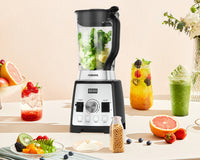By now you’ve probably heard about HEPA filters in Air Purifiers, Vacuum cleaners, and basically any appliance that is used to clear the air. But what is HEPA filter and why is it so efficient? Let’s see what’s the science behind it…

What is HEPA filter?
Let’s start from the name “HEPA” filter – what does “HEPA” stands for? “HEPA” is an acronym for "High Efficiency Particulate Air" (as defined by the U.S. Department of Energy). The HEPA filter does what its name stands for, it filters air (particles) with high efficiency. According to theory, it can filter out 99.97% of all particles size 0.3µm (microns); in our homes those particles are usually dust, pollen, mold, some bacteria, and basically any airborne particles that come in that size. But why 0.3µm particularly? That is because that specific micron size particle is referred to by scientists as the most penetrating particle size (MPPS); this size particles evade air filters more than larger or smaller ones (there is some serious, but in essence simple, physics behind it…and that is actually the key how HEPA filters work; we’ll mention that later). Although often mentioned in recent years, HEPA filters are really a new technology; they date back to World War II, when HEPA filters were first created and used by American scientists with the Manhattan Project for the needs to capture radioactive particles released during the creation of the atomic bomb.
How does HEPA filter has such high efficiency? HEPA filters are basically a mash of tangled fibers that are typically composed of polypropylene or fiberglass with diameters between 0.5µm and 2.0µm. HEPA filters stop the particles using 3 different methods depending on the particle size; the methods used are:
- Diffusion - Particles below 0.3μm are captured by diffusion in a HEPA filter. This mechanism is a result of the collision with gas molecules by the smallest particles, especially those below 0.1μm in diameter. The small particles are effectively blown or bounced around and collide with the filter media fibers. This behavior is similar to Brownian motion and raises the probability that a particle will be stopped by either interception or impaction; this mechanism becomes dominant at lower airflow.
- Interception - Particles following a line of flow in the air stream come within one radius of a fiber and adhere to it. Mid-size particles are being captured by this process.
- Impaction - Larger particles are unable to avoid fibers by following the curving contours of the air stream and are forced to embed in one of them directly; this effect increases with diminishing fiber separation and higher air flow velocity.

Where is HEPA Filter used?
As we already mentioned, HEPA filters have wide spread use. But where we hear about them most often is in home appliances, such as Air Purifiers, Vacuum Cleaners, Air Conditioners (some version), and basically any appliance that filters air; but also in car air filters, airplanes, hospitals…
A thing to pay attention to, when looking for products with filters, is filter’s efficiency. This efficiency is presented in MERV Rating. MERVs, or Minimum Efficiency Reporting Values, basically report a filter's ability to capture particles that are 0.3µm to 10µm (microns).

With technology advancement and production prices getting lower HEPA filter become a basic standard in air filtration. Nowadays we usually have combination of several filters so that even particles under 0.3μm can be filtered out. Also, don’t be confused with all the marks that come with HEPA mark (H13, True HEPA…); US Government recognize only “HEPA filter” but doesn’t recognize “True HEPA”! However, since it’s been used as marketing tool or selling point do check what does it actually mean:
- EPA “Efficient Particulate Air”, with classification levels: E10, E11 and E12.
- HEPA “High Efficiency Particulate Air”, which include two levels of classification: H13 with an efficiency of 99.95% and H14 with 99.995%. The True HEPA Filter (99,97%) performance is in between the H13 and H14.
- ULPA “Ultra Low Penetration Air”, with three levels of classification U15, U16 and U17.

Hope this article helps you to decide what Air Purifier you want to buy, and in the first place that you should buy.












